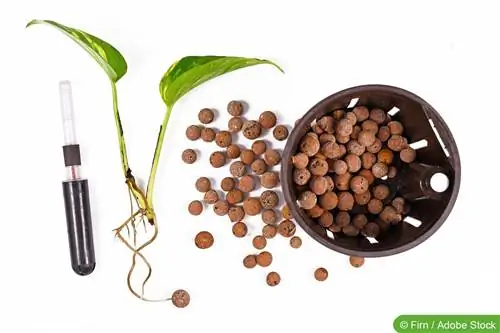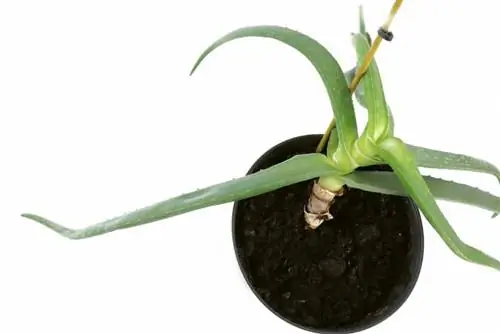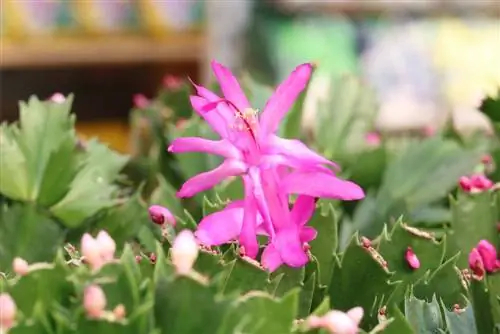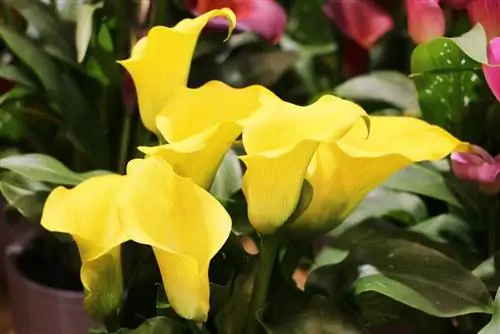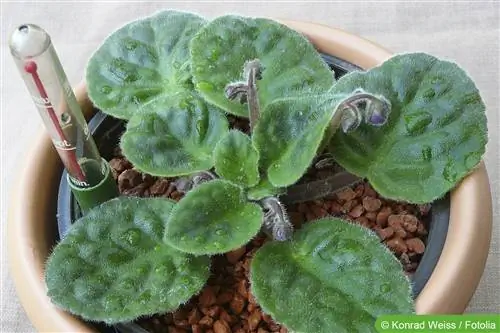- Author admin [email protected].
- Public 2023-12-17 03:39.
- Last modified 2025-01-24 12:45.
The plants in hydroponics are rooted in an inorganic substrate and are supplied with water and a special nutrient solution. The watering intervals are longer because there is a liquid reservoir at the bottom of the hydro vessel. The roots don't extend that much and the plant rarely needs to be repotted.
Most houseplants, with a few exceptions, are also suitable for hydroponics. The purchase and maintenance of a hydroponic culture is slightly more expensive compared to normal culture in potting soil.
Purchasing
You usually get the whole package from hydroponics providers:
- Plant (palms, ferns, leafy plants are best)
- waterproof planter
- Water level indicator
- Substrate (expanded clay)
Of course you can put something together according to your individual preferences. For example, you can also use other waterproof pots as containers. Any other inorganic material is conceivable as a substrate, for example gravel or volcanic rock (bas alt, perlite). The hydroponic plant is approximately 20-30% more expensive to purchase than conventional houseplants in potting soil.
Substrates
The expanded clay balls are made from clay by firing the clay in a drum kiln at over a thousand degrees. Expanded clay does not store water. Substrates made from volcanic rock, such as bas alt and perlite, can store nutrients and water for long periods of time. Sand and gravel are not particularly suitable because, firstly, they are difficult to keep clean and secondly, they are very heavy. Otherwise, you could create a hydroculture with any inorganic, preferably lime-free, sterilized substrate that can give the roots support due to a crumbly structure. Requirements for the substrate:
- inorganic
- lime-free
- crumbly structure
The most common substrates for hydroponics:
- expanded clay
- Perlite
- Bas alt
- Mineral wool (for cultivation)
- Gravel, sand (heavy; not for sensitive roots)
- Styrofoam flakes (very cheap, not very decorative)
Pouring
With the water level indicator, watering is quite easy. It's a good way to bridge a few days of vacation, and the flower suppliers will also get along well with the water level indicator. There are three water levels that are displayed and are worth keeping an eye on. The goat level should be checked once or twice a week:
- Minimum: if the water level is below this, water is added until:
- Optimum: normal pouring level
- Maximum: fill up with water up to this point, then the plants can usually manage on their own for around three weeks.
Despite the water level indicator, most hydro plants die because they are watered too frequently. When the level is at minimum, you don't have to water again immediately. Depending on the location (sunny or shady), you can wait 2-5 days before filling up to the optimum again. Depending on the plant, location and pot size, the watering intervals can vary greatly. A large plant in a relatively small container in a sunny south-facing window may need to be watered every four days. A smaller plant in a container of the same size in the shade will last for a month with the same water ration.
Fertilize
Since it is an inorganic substrate and even pure water does not provide the nutrients it needs, regular fertilizer applications are vital for the plant. Basically there are two options:
- Liquid fertilizer for irrigation water
- Long-term fertilizers in tablet form that are added to the water reservoir
Under no circumstances should you use normal universal fertilizer or fertilizer sticks for normal culture in soil. The needs of hydroponic plants are too specific. The fertilizers for hydroponics contain, among other things, special additives for pH balance.
Repotting
By growing in an inorganic material and with a water supply in the lower part of the container, the plant develops special water roots. These penetrate relatively straight downwards and do not branch out as much as earth roots. This has two advantages: these roots cope better with waterlogging and they don't need to be repotted as often.
- All waterproof containers are suitable (metal containers and glazed clay pots are not suitable)
- for small plants: inner pot (especially for hydroponics) plus waterproof planter
- Carefully remove the plant from the substrate
- Place the plant in the new container and fill with substrate, placing the pot on the pot several times to ensure an even distribution
- new substrate is not absolutely necessary (clean and sterilize the old substrate in advance if necessary)
- then fill with lime-free water at room temperature up to the “Maximum” mark
Conversion
Transferring a plant from soil to hydroponics is not always successful. This works best with small offshoots that have formed their roots in the air (e.g. green line). Older plants have significantly more problems converting their roots from soil to water. When making the change, you have to be very careful to ensure that no soil remains stick to the roots. Soil residue can lead to fungal infestation and root rot. Conversely, switching from hydroculture to soil culture is also problematic. Most of the time, the long, water-accustomed roots then rot in the soil.
If you still want to try switching a plant from potting soil to hydroponics, you need to keep the following in mind:
- Remove the roots of the earth-grown plant completely from the soil.
- Then carefully insert into the substrate, as when repotting.
- Afterwards a lot of humidity, because the roots first have to reach the water (takes about three weeks).
Cleaning
Hydroponic plants are easier to care for, as they require less watering and are repotted less often. Nevertheless, the often very beautiful and impressive leaves and palm fronds of hydroponics must be freed from dust and other deposits so that they can breathe. Apart from that, shiny, green leaves also look better visually. Wilted and dried plant parts should be removed so that the organic substances do not contaminate the inorganic substrate. The substrate can also be rinsed once a year. Immersed in a bath of vinegar for a few hours also has a sterilizing effect.
Diseases, pests
Even with easy-care hydroponics, diseases and pests can spread, usually due to care and location errors. Therefore:
- keep the substrate clean (no waste, no plant parts, no leftover drinks)
- It is essential to maintain regular drying phases, otherwise the leaves will brown due to too much watering
- Hydrocultures need more light than plants in potting soil, otherwise brown leaves because the location is too dark
- Root rot can also occur in hydroponics if dry periods are not observed or watering is always carried out to the maximum
- brown leaves, stunted growth, this can also be due to irrigation water that is too hardy (use stale water or rainwater)
Black or green lice can appear on the young shoot tips, especially if the location is not so favorable. These can be easily wiped off with a detergent solution. Oily, natural-based sprays (neem oil) help against mealybugs and mealybugs.
Conclusion of the editors
Hydroponics has, unfairly, become somewhat out of fashion. Depending on the requirements, it offers a certain group perfect, low-maintenance greenery, including for private rooms. The brown standard spheres no longer have to be used as a substrate. You no longer have to rely on the gray office containers as containers. Hydroponic containers in modern colors and shapes have long been available for purchase.
What you should know about hydroponics in brief
- In hydroponics, the plants are rooted in a culture container with expanded clay. The vessel is in a planter with water.
- A water level indicator enables checking and individual supply of water and fertilizer.
- Fertilizing is essential for hydro plants because, unlike in the soil, there are no nutrients available.
- There are special fertilizers for hydroponics that contain a balanced composition of nutrients and bind lime.
- The substrate is more hygienic than soil and therefore suitable for allergy sufferers as it does not form mold.
- Watering the plant is only necessary when the water level indicator has dropped to the minimum.
- Then add enough water until the display is approximately in the middle.
- If you are away for a longer period of time, you can water up to the maximum indicated.
- Watering indicators can become rooted in the plant, then the function is restricted or fails completely.
- For this reason, the scoreboard should be renewed once a year.
Tip:
As an alternative to the expanded clay substrate, there are also clay granules.
This is a combination of earth and hydroculture. Small clay particles are in the soil and give the plant additional support. They store water and release nutrients to the roots. Clay granules are also hygienic, low-allergenic, have a long shelf life and are watered less often. All plants can be switched to clay granules at any time, as the root ball is retained and the granules are additionally supplemented. A watering indicator is also very important for clay granules; it should be inserted directly into the ball of soil.

